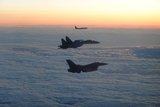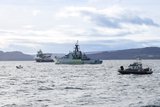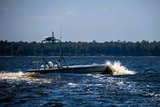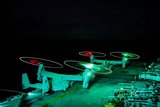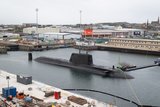USN and RAN to receive advanced anti-submarine warfare suite
Graphic depicting AN/SQQ-89A in action. (Image: USN)
The USN and Royal Australian Navy (RAN) will received upgraded hardware to support development, integration, manufacture, production, and testing of the AN/SQQ-89A(V)15 anti-submarine warfare (ASW) combat system suite, the DoD announced on 9 May.
A $67.85 million contract modification from Naval Sea Systems Command will see Lockheed Martin Rotary and Mission Systems provide Technical Insertion-20 (TI-20) AN/SQQ-89A(V)15 systems plus AN/SQS-53C transmitter infrastructure shipset hardware.
Work will be completed by August 2024.
The latest announcement follows an $80.24 million modification for AN/SQQ-89A(V)15, awarded in July 2021.
AN/SQQ-89A(V)15 uses passive sonar to provide early warning of threat torpedoes. The open-architecture system requires software upgrades every two years and TI hardware upgrades every four years.
Related Equipment in Defence Insight
More from Naval Warfare
-
![How the UK Royal Navy is powering up its hybrid fleet to combat new threats]()
How the UK Royal Navy is powering up its hybrid fleet to combat new threats
Since it announced its move towards a new “hybrid navy” earlier this year, the force has announced a number of new uncrewed technologies in the works.
-
![US and UK to begin Trident II D5 Increment 8 in October 2026]()
US and UK to begin Trident II D5 Increment 8 in October 2026
Trident II D5 Increment 8 will involve improvements to the shipboard navigation subsystem for the US Ohio and Columbia and the UK Dreadnought and Vanguard submarine classes.
-
![US Navy starts acquisition process for uncrewed maritime systems for support missions]()
US Navy starts acquisition process for uncrewed maritime systems for support missions
The USN is interested in uncrewed capabilities that can carry out explosive ordnance disposal, mine countermeasures, force protection, ISR and anti-submarine missions.
-
![What capabilities has the US deployed in the Caribbean and South America to engage “drug boats”?]()
What capabilities has the US deployed in the Caribbean and South America to engage “drug boats”?
The US arsenal includes amphibious assault and littoral combat ships, cutters, destroyers, landing platform docks, a nuclear-powered fast attack submarine, drones, ISR aircraft, helicopters and fighters.
-
![HMS Agamemnon: details of the dive and what the Astute-class signifies for the UK Royal Navy]()
HMS Agamemnon: details of the dive and what the Astute-class signifies for the UK Royal Navy
As HMS Agamemnon moves closer towards joining the UK’s in-service submarine fleet, how does the sixth Astute-class fit into the Royal Navy’s defence strategy?
-
![French Navy frigates to align with Hellenic Navy after Aster missile enhancement]()
French Navy frigates to align with Hellenic Navy after Aster missile enhancement
The FDI frigates will have an enhanced warfare capability that matches the configuration of ships ordered by Greece.







